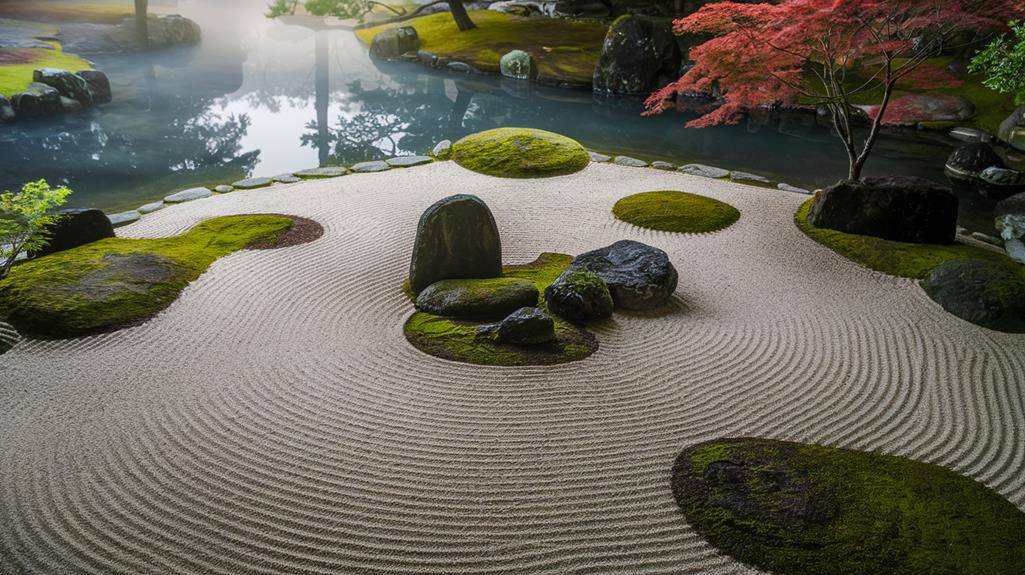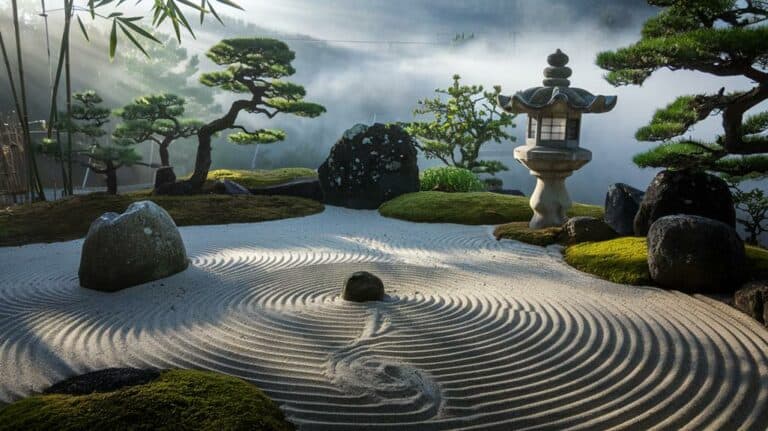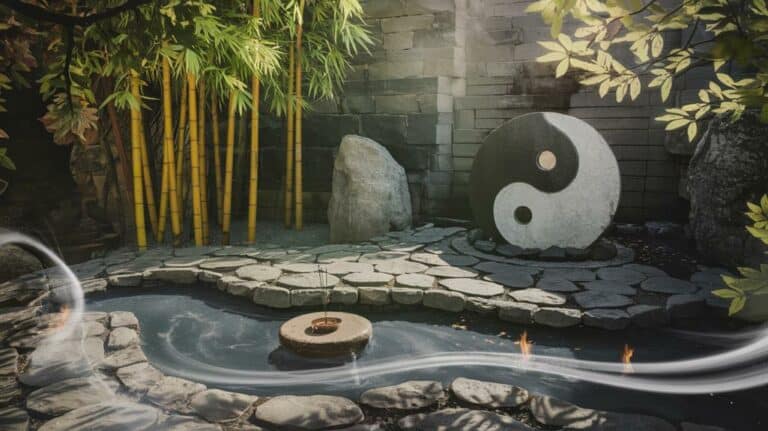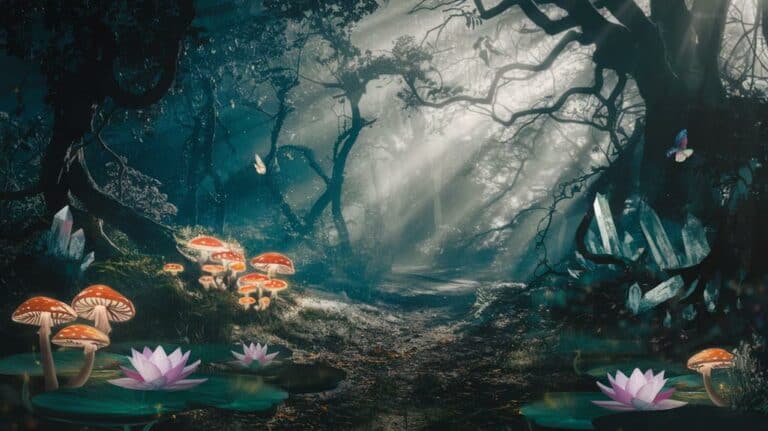10 Zen Gardens That Will Soothe Your Soul
In today’s fast-paced world, you’re likely searching for moments of tranquility and inner peace. While meditation apps and wellness retreats offer temporary respite, nothing quite matches the profound serenity of a masterfully designed Zen garden. These sacred spaces, crafted over centuries, combine natural elements with intentional design to create environments where your mind can finally rest. From the legendary rock arrangements of Kyoto to hidden sanctuaries in the Pacific Northwest, these ten remarkable gardens hold the power to transform your state of being. Let’s explore these havens where time seems to stand still and wisdom whispers through carefully placed stones.
Ryoan-ji Temple Garden, Kyoto
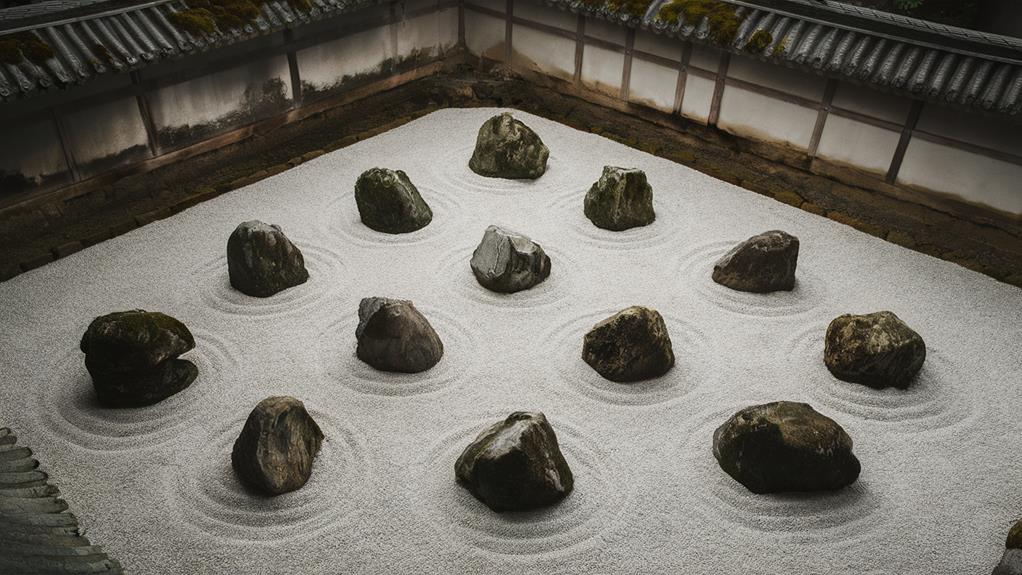
The Ryoan-ji Temple Garden stands as Japan’s most famous rock garden and a masterpiece of Zen design. As you gaze upon its rectangular expanse of meticulously raked gravel, you’ll discover fifteen carefully placed rocks, arranged in five distinct groups.
The garden’s deceptive simplicity invites you to contemplate life’s deeper meanings while the surrounding earthen walls create an intimate space for reflection.
You’ll find that no matter where you sit along the viewing platform, at least one rock remains hidden from your view – a deliberate design choice that speaks to the impossibility of seeing the complete truth from any single perspective.
The garden’s minimalist composition, dating back to the late 15th century, continues to challenge your understanding of space, perception, and existence itself.
As the patterns in the gravel ripple outward like waves on a silent sea, you’re drawn into a meditative state where time seems to pause.
The garden’s enduring mystery has sparked countless interpretations: some see islands in an ocean, others perceive abstract concepts of infinity, while many find personal meanings in its enigmatic design.
Portland Japanese Garden
While Ryoan-ji captures Zen minimalism in its purest form, Portland Japanese Garden offers a more diverse exploration of Japanese garden styles.
You’ll discover five distinct gardens within its 12 acres, each revealing a different facet of Japanese landscaping philosophy. As you wander through the Tea Garden‘s mossy stepping stones, you’ll feel centuries of tradition beneath your feet.
The Stroll Garden beckons you along winding paths where strategically placed stones and carefully pruned trees frame Mount Hood in the distance.
In the Sand and Stone Garden, you’ll witness how raked gravel can mirror the ripples of an ancient ocean, while the Natural Garden demonstrates the profound beauty of controlled wilderness.
The Flat Garden, perhaps the most contemplative space, invites you to sit on the viewing porch and let your mind drift across its carefully composed landscape.
Unlike many Japanese gardens outside Japan, Portland’s masterpiece doesn’t merely imitate – it translates these time-honored principles into a uniquely Pacific Northwest context.
You’ll find yourself moving through a living meditation, where every turn reveals another layer of meaning waiting to be discovered.
Bloedel Reserve Zen Garden
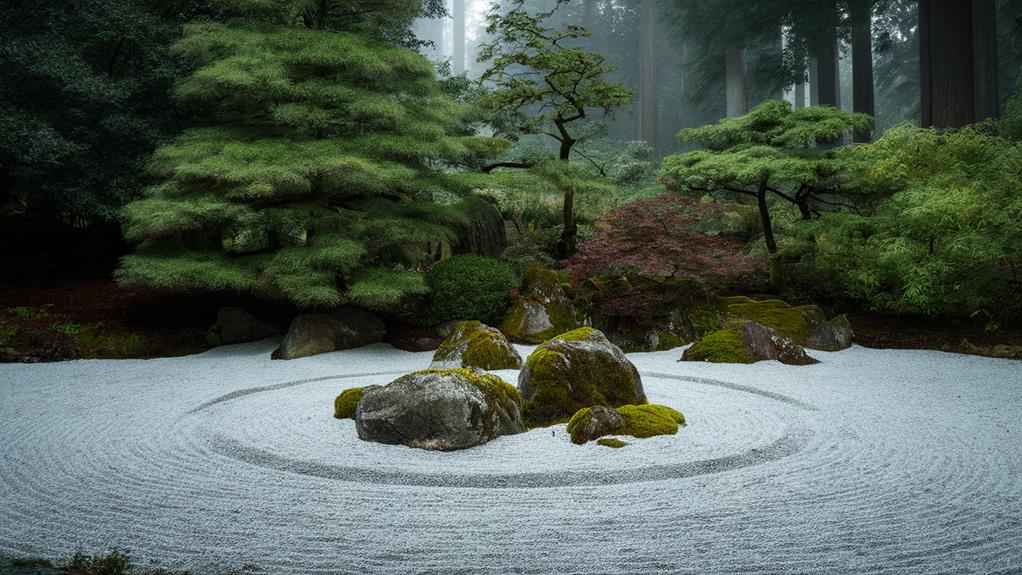
Nestled on Bainbridge Island near Seattle, Bloedel Reserve‘s Zen Garden offers a distinctly Pacific Northwest interpretation of Japanese meditation spaces. You’ll find yourself wandering through a masterful blend of moss-covered grounds and carefully placed stones, where towering Western red cedars replace traditional bamboo, creating a uniquely regional meditation experience.
The garden’s design invites you to pause and reflect, as filtered sunlight dances through the evergreen canopy above. As you follow the thoughtfully arranged pathways, you’ll discover how the garden’s creator, Prentice Bloedel, sought to capture the essence of contemplation while honoring the natural landscape of the Pacific Northwest.
The garden’s most striking feature is its rectangular reflection pool, where you can witness the interplay between sky, water, and surrounding forest. The pool’s still surface mirrors the changing seasons, from summer’s clear blues to autumn’s golden hues, offering endless opportunities for meditation and self-discovery.
You’ll notice how the careful integration of native plants and moss-draped rocks creates a seamless connection between the cultivated garden and the wild forest beyond, embodying the Zen principle of unity with nature.
Nanzen-ji Temple Sand Garden
Among Kyoto’s most revered Zen landscapes, Nanzen-ji Temple’s sand garden stands as a masterpiece of minimalist design. As you enter this sacred space, you’ll find yourself drawn into a world where carefully raked gravel ripples outward like waves in an endless sea, creating patterns that seem to shift with each changing shadow and perspective.
You’ll discover that the garden’s profound simplicity invites your mind to settle into deep contemplation. Large stones, weathered by centuries, emerge from the sea of sand like ancient islands, their placement following precise principles of asymmetrical balance.
The garden’s eastern wall, lined with moss-covered stones, frames your view while connecting earth to sky in a seamless visual journey.
What makes this garden extraordinary isn’t just its aesthetic appeal – it’s the way it transforms your consciousness. As you sit on the viewing platform, you’ll notice how the garden’s rhythmic patterns begin to influence your breathing, slowing your thoughts until you’re in perfect harmony with the space.
The absence of ornate elements forces you to confront the essential nature of existence, making this garden a powerful tool for meditation and self-discovery.
Hamilton Gardens Peace Garden
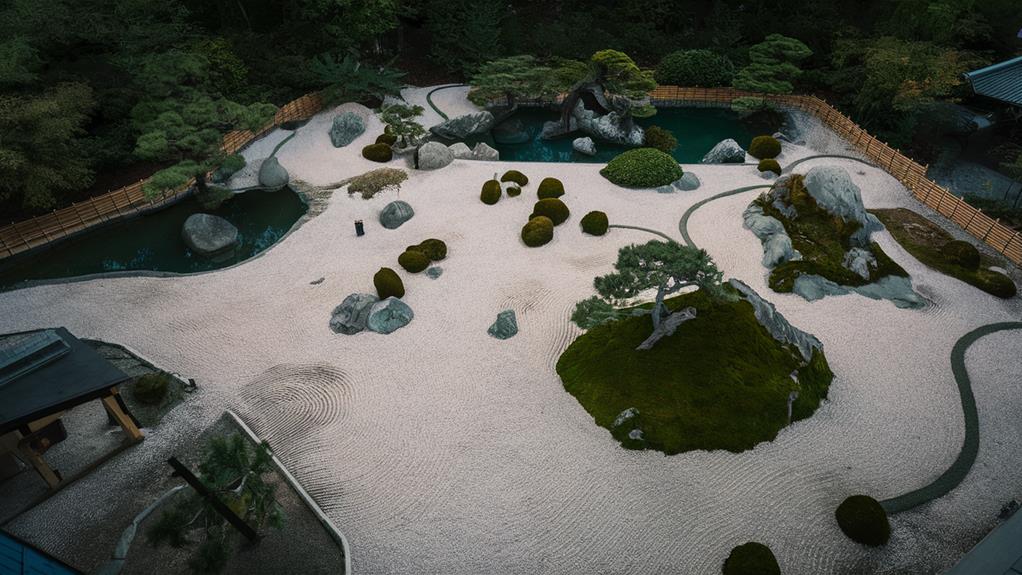
Since its creation in 1991, the Hamilton Gardens Peace Garden has blended Japanese Zen principles with New Zealand’s natural landscape. You’ll discover how native Kiwi plants harmonize with traditional Japanese elements, creating a space where East meets South Pacific in profound meditation.
As you walk the thoughtfully designed paths, you’ll encounter carefully positioned rocks that seem to emerge from waves of gravel, each one inviting you to reflect on its ancient presence.
The garden’s most striking feature is its central pond, where you’ll find yourself reflected in waters that mirror both sky and surrounding greenery, offering a moment to ponder your place in nature’s vast tapestry.
You’ll notice how the garden’s designers have incorporated local materials, including New Zealand schist and indigenous ferns, alongside traditional Japanese maples and bamboo. This cultural fusion doesn’t just create aesthetic beauty – it speaks to deeper truths about unity and interconnectedness.
When you reach the viewing platform, you’re presented with a contemplative vista that invites you to release your everyday concerns and embrace the garden’s serene emptiness, where you’ll find that silence itself becomes a teacher.
Chicago Botanic Garden
The Elizabeth Hubert Malott Japanese Garden stands as the crown jewel of Chicago Botanic Garden‘s Zen offerings. You’ll find yourself wandering through 17 acres of meticulously curated spaces where each element serves a deeper purpose in the contemplative journey.
As you cross the arching bridges, you’ll witness your reflection merge with the koi swimming beneath, creating a moment of profound connection between self and nature.
Within this serene sanctuary, you’ll discover how three distinct islands emerge from the waters, each representing a philosophical stage in your spiritual journey. The dry gravel garden, raked in precise patterns, invites you to contemplate the ripples of existence while the waterfall’s gentle cascade reminds you of life’s continuous flow.
You’ll notice how carefully placed stones anchor your consciousness to the present moment, while pruned pines frame views that shift with each step you take.
When you need respite from life’s chaos, this garden offers more than aesthetic pleasure—it provides a space where you can rediscover your center through the ancient wisdom of Japanese garden design.
Taizo-in Temple Garden
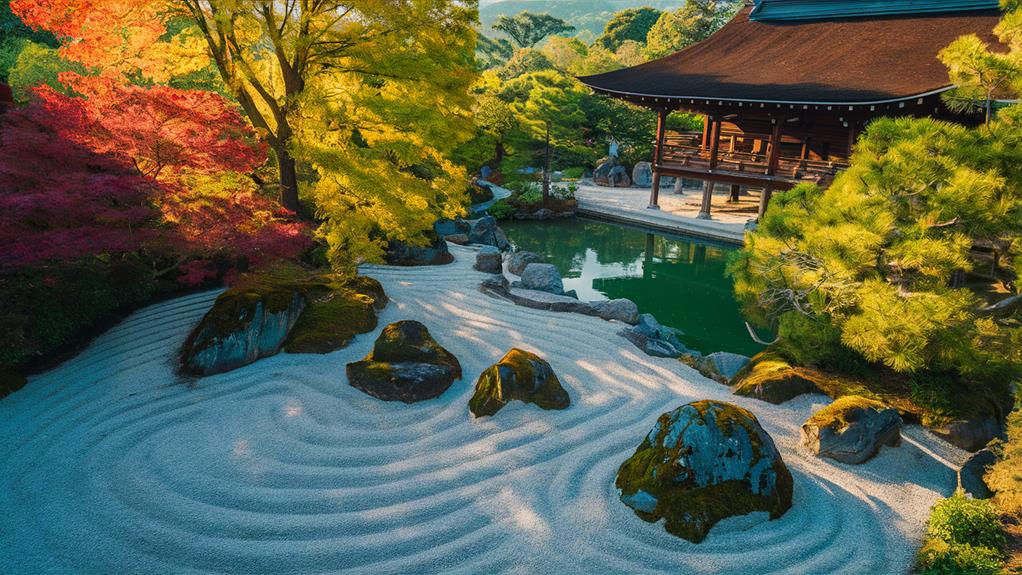
Visitors to Kyoto’s Taizo-in Temple discover one of Japan’s most intimate dry landscape gardens, dating back to 1404. You’ll find yourself drawn to the masterful arrangement of rocks and raked gravel, where each element has been thoughtfully positioned to create a profound sense of harmony.
As you move along the viewing platform, you’ll notice how the garden’s design shifts subtly with each step, revealing new perspectives that challenge your understanding of space and time.
The garden’s most compelling feature is its ability to manifest infinity within its confined boundaries. You’ll witness how the carefully placed stones emerge from the sea of gravel like islands in an endless ocean, while meticulously pruned azalea bushes provide fleeting moments of color against the garden’s monochromatic palette.
When you sit in contemplation, you’ll begin to understand why monks have meditated here for centuries. The garden’s rhythmic patterns and deliberate asymmetry quiet your mind, allowing you to experience the profound emptiness that lies at the heart of Zen philosophy.
Here, you’ll discover that true freedom exists not in physical space, but in the boundless domain of consciousness.
Zuiho-in Rock Garden
While Taizo-in exemplifies traditional Zen aesthetics, Zuiho-in’s rock garden breaks convention with its bold Christian symbolism. As you enter this contemplative space at Daitoku-ji temple in Kyoto, you’ll encounter an extraordinary fusion of Eastern and Western spirituality, where carefully positioned rocks form the shape of a cross when viewed from the temple’s veranda.
You’ll find yourself drawn to the garden’s stark composition, where white gravel represents the vast ocean of existence, and dark rocks emerge like islands of consciousness in an infinite sea.
The garden’s designer, Mirei Shigemori, deliberately created this powerful intersection of faith traditions in 1961, honoring the temple’s connection to Otomo Sorin, a 16th-century Christian daimyo.
As you observe the landscape from different angles, you’ll notice how the cross transforms into other shapes, suggesting the fluid nature of religious experience and the interconnectedness of spiritual paths.
The surrounding moss and minimal plantings frame this profound statement, inviting you to reflect on the boundaries between different belief systems and the universal human quest for meaning.
In this sacred space, you’ll discover that spiritual truth transcends cultural divisions.
Ginkaku-ji Silver Pavilion Gardens
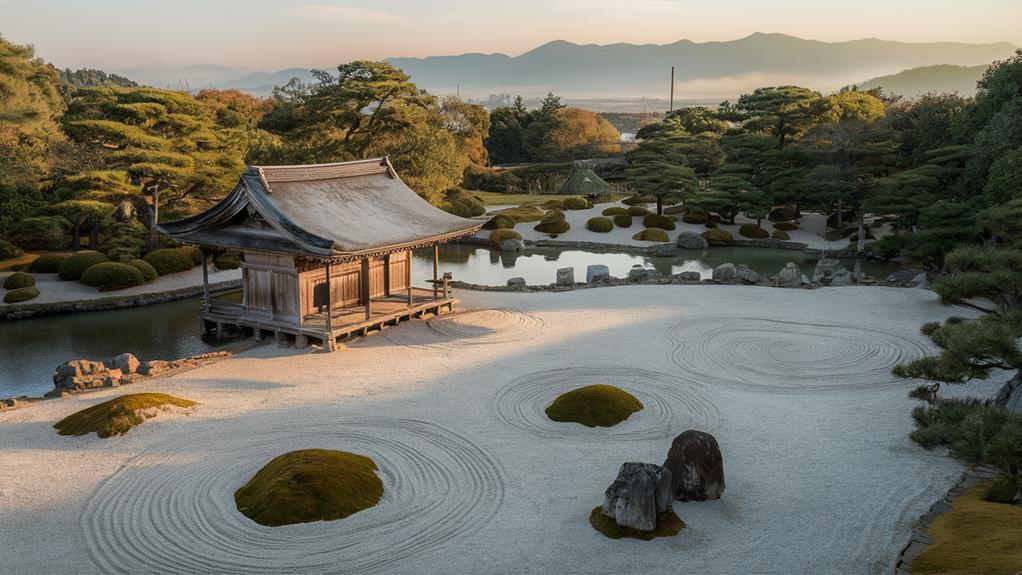
Serenity flows through every carefully curated element of Ginkaku-ji’s renowned gardens, where two distinct styles showcase the evolution of Japanese landscape design.
You’ll find yourself drawn first to the meticulously maintained dry sand garden known as the Sea of Silver Sand, where precise geometric patterns ripple outward like waves frozen in time. The garden’s centerpiece, a sculpted sand cone called the Moon Viewing Platform, stands as a silent symbol to humanity’s eternal connection to natural cycles.
As you venture deeper into the grounds, you’ll discover the moss garden‘s verdant pathways winding through ancient pines and carefully pruned shrubs.
Water flows with deliberate purpose through stone channels, its gentle murmur echoing the whispered wisdom of centuries past. The garden’s upper pathway reveals breathtaking views of Kyoto, reminding you that even in moments of profound contemplation, you remain connected to the world beyond these walls.
Each element – from the weathered stones to the reaching branches of maple trees – invites you to pause, reflect, and find your own meaning within this masterpiece of philosophical landscape design.
Geneva Japanese Garden
Moving from Kyoto’s ancient grounds to Switzerland’s shores, the Geneva Japanese Garden stands as Europe’s remarkable interpretation of Zen aesthetics.
You’ll find this hidden sanctuary nestled within the Jardin Botanique, where Swiss precision meets Japanese minimalism in a harmonious blend that transcends cultural boundaries.
As you wander along the carefully raked gravel paths, you’ll discover how the garden’s designers have captured the essence of traditional Japanese landscaping while adapting it to Lake Geneva’s alpine backdrop.
The garden’s meditation areas offer you moments of profound stillness, where carefully positioned rocks and meticulously pruned bonsai trees invite you to contemplate life’s deeper meanings.
You’ll notice how water features whisper ancient wisdom through their gentle movements, while maple trees cast ever-changing shadows across moss-covered stones.
The garden’s most compelling feature isn’t its physical elements but rather the space between them – the ma – where you’ll find yourself discovering unexpected insights.
Here, in this cross-cultural haven, you’re reminded that the principles of Zen transcend geography, offering universal truths that speak to your soul’s yearning for peace and understanding.



